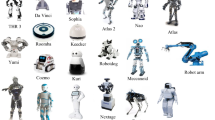Abstract
The aim of the study presented in this paper is to develop a quantitative evaluation tool of the sense of safety and security for robots in eldercare. By investigating the literature on measurement of safety and security in human-robot interaction, we propose new evaluation tools. These tools are semantic differential scale questionnaires. In experimental validation, we used the Pepper robot, programmed in the way to exhibit social behaviors, and constructed four experimental conditions varying the degree of the robot’s non-verbal behaviors from no gestures at all to full head and hand movements. The experimental results suggest that both questionnaires (for the sense of safety and the sense of security) have good internal consistency.
Access this chapter
Tax calculation will be finalised at checkout
Purchases are for personal use only
Similar content being viewed by others
References
Pepper. https://www.ald.softbankrobotics.com/en/cool-robots/pepper. Accessed 30 June 2017
Bartneck, C., Kulić, D., Croft, E., Zoghbi, S.: Measurement instruments for the anthropomorphism, animacy, likeability, perceived intelligence, and perceived safety of robots. Int. J. Social Robot. 1(1), 71–81 (2009)
Bicchi, A., Peshkin, M.A., Colgate, J.E.: Safety for physical human-robot interaction. In: Siciliano, B., Khatib, O. (eds.) Springer Handbook of Robotics, pp. 1335–1348. Springer, Heidelberg (2008)
Boholm, M., Möller, N., Hansson, S.O.: The concepts of risk, safety, and security: applications in everyday language. Risk Anal. 36, 320–338 (2015)
Bradley, M.M., Lang, P.J.: Measuring emotion: the self-assessment manikin and the semantic differential. J. Behav. Ther. Exp. Psychiatry 25(1), 49–59 (1994)
Cortellessa, G., Scopelliti, M., Tiberio, L., Svedberg, G.K., Loutfi, A., Pecora, F.: A cross-cultural evaluation of domestic assistive robots. In: AAAI Fall Symposium: AI in Eldercare: New Solutions to Old Problems, pp. 24–31 (2008)
Walters, M.L., et al.: Evaluating the robot personality and verbal behavior of domestic robots using video-based studies. Adv. Robot. 25(18), 2233–2254 (2011)
Fischinger, D., Einramhof, P., Papoutsakis, K., Wohlkinger, W., Mayer, P., Panek, P., Hofmann, S., Koertner, T., Weiss, A., Argyros, A., et al.: Hobbit, a care robot supporting independent living at home: first prototype and lessons learned. Robot. Auton. Syst. 75, 60–78 (2016)
Fonad, E., Wahlin, T.B.R., Heikkila, K., Emami, A.: Moving to and living in a retirement home: focusing on elderly people’s sense of safety and security. J. Hous. Elder. 20(3), 45–60 (2006)
Haddadin, S., Albu-Schäffer, A., Hirzinger, G.: Safe physical human-robot interaction: measurements, analysis and new insights. In: Kaneko, M., Nakamura, Y. (eds.) Robotics Research. STAR, vol. 66, pp. 395–407. Springer, Heidelberg (2010)
Heerink, M., Kröse, B., Evers, V., Wielinga, B.: Assessing acceptance of assistive social agent technology by older adults: the almere model. Int. J. Social Robot. 2(4), 361–375 (2010)
Kamide, H., Mae, Y., Kawabe, K., Shigemi, S., Hirose, M., Arai, T.: New measurement of psychological safety for humanoid. In: Proceedings of the Seventh Annual ACM/IEEE International Conference on Human-Robot Interaction, pp. 49–56. ACM (2012)
Kornecki, A.J., Liu, M.: Fault tree analysis for safety/security verification in aviation software. Electronics 2(1), 41–56 (2013)
Lasota, P.A., Rossano, G.F., Shah, J.A.: Toward safe close-proximity human-robot interaction with standard industrial robots. In: 2014 IEEE International Conference on Automation Science and Engineering (CASE), pp. 339–344. IEEE (2014)
Lichtenthäler, C., Lorenzy, T., Kirsch, A.: Influence of legibility on perceived safety in a virtual human-robot path crossing task. In: Proceedings of 2012 IEEE ROMAN, pp. 676–681. IEEE (2012)
Maslow, A.H.: A theory of human motivation. Psychol. Rev. 50(4), 370–396 (1943)
Nonaka, S., Inoue, K., Arai, T., Mae, Y.: Evaluation of human sense of security for coexisting robots using virtual reality. 1st report: evaluation of pick and place motion of humanoid robots. In: Proceedings 2004 IEEE International Conference on Robotics and Automation, ICRA 2004, vol. 3, pp. 2770–2775. IEEE (2004)
Piètre-Cambacédès, L., Chaudet, C.: The SEMA referential framework: avoiding ambiguities in the terms security and safety. Int. J. Crit. Infrastruct. Prot. 3(2), 55–66 (2010)
Russell, J.: A circumplex model of affect. J. Pers. Soc. Psychol. 39, 1161–1178 (1980)
Theodoridis, T., Hu, H.: Toward intelligent security robots: a survey. IEEE Trans. Syst. Man Cybern. Part C (Appl. Rev.) 42(6), 1219–1230 (2012)
Weiss, A., Bartneck, C.: Meta analysis of the usage of the Godspeed questionnaire series. In: 2015 24th IEEE International Symposium on Robot and Human Interactive Communication (ROMAN), pp. 381–388. IEEE (2015)
Wyrobek, K.A., Berger, E.H., Van der Loos, H.F.M., Salisbury, J.K.: Towards a personal robotics development platform: rationale and design of an intrinsically safe personal robot. In: 2008 IEEE International Conference on Robotics and Automation, pp. 2165–2170, May 2008
Author information
Authors and Affiliations
Corresponding author
Editor information
Editors and Affiliations
Rights and permissions
Copyright information
© 2017 Springer International Publishing AG
About this paper
Cite this paper
Akalin, N., Kiselev, A., Kristoffersson, A., Loutfi, A. (2017). An Evaluation Tool of the Effect of Robots in Eldercare on the Sense of Safety and Security. In: Kheddar, A., et al. Social Robotics. ICSR 2017. Lecture Notes in Computer Science(), vol 10652. Springer, Cham. https://doi.org/10.1007/978-3-319-70022-9_62
Download citation
DOI: https://doi.org/10.1007/978-3-319-70022-9_62
Published:
Publisher Name: Springer, Cham
Print ISBN: 978-3-319-70021-2
Online ISBN: 978-3-319-70022-9
eBook Packages: Computer ScienceComputer Science (R0)




